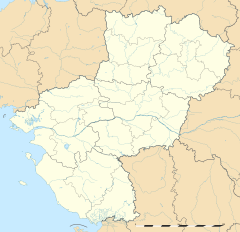Noirmoutier Abbey otherwise the Abbey of Saint Philibert, Noirmoutier (French: Abbaye Saint-Philibert de Noirmoutier) was a Benedictine monastery founded in 674 on the island of Noirmoutier by Philibert of Jumièges or of Tournus, who died there on August 20, 684.
| Noirmoutier Abbey aka Abbey of St Philibert, Noirmoutier Abbaye Saint-Philibert de Noirmoutier | |
|---|---|
 The crypt. | |
| Religion | |
| Affiliation | Catholic church |
| District | Noirmoutier-en-l'Île |
| Province | Vendée |
| Region | Pays de la Loire |
| Location | |
| Country | France |
| Geographic coordinates | 47°0′1.06″N 2°14′27.85″W / 47.0002944°N 2.2410694°W |
| Architecture | |
| Destroyed | 18th century |
History
editPhilibert,[1] in conflict with Ébroïn, mayor of the Neustrian palace, had to leave the abbey at Jumièges near Rouen which he had founded. He was welcomed by the bishop of Poitiers, Ansoald, whom he helped to evangelize his diocese, and then withdrew with a few monks from Jumièges to the island of Her, now Noirmoutier. On July 1, 677, Ansoald gave the monks his villa at Déas and other lands that would enable the development of the abbey.
First called Herio, then Hermoutier, the monastery took the name Noirmoutier from the color of the Benedictine monks who lived there. The monastery made its living from salt marshes[2] and farming, and traded with the mainland via its port. The abbey flourished until it was destroyed by the Saracens in 732.[3] In 799, a Scandinavian fleet attacked and plundered the monastery.[4]
Noirmoutier Abbey was re-established in 804 by Louis the Pious, King of Aquitaine. It was pillaged several times between 814 and 819 by the Normans.[5] The monks built a new abbey at Déas, on the shores of Lac de Grand-Lieu, after obtaining authorization from Louis the Pious, now Emperor, to divert the Boulogne river[6] in 819. Noirmoutier was again sacked by the Vikings in 824,[7] 830 and 835, and the abbey was finally burnt down in 846. The island became a base for Viking operations on the Loire.[8]
On June 7, 836, the monks left the island for Déas, carrying the reliquary containing the body of Saint Philibert. Driven out again by the Vikings in 847, they took refuge at the priory of Cunault-sur-Loire, which had been given to them as a retreat in 845. They took the relics of Saint Philbert there in 857, but had to flee again from the Normans in 862, to Messais in Poitou, on an estate donated by Charles the Bald. By 870, they were in Saint-Pourçain-sur-Sioule in Auvergne, arriving in Tournus, in the Mâconnais region, in 875 after a long peregrination with the relics of their holy founder.[6] Here, they founded the Abbey of St Philibert. The monastery at Noirmoutier was reduced to a priory under the abbey at Tournus around the year 1000.
In 1172, a community of Cistercian monks settled on the Île du Pilier, then obtained a charter from Lord Pierre IV de Beauvoir to establish themselves in Noirmoutier in 1205. To the north of the island, the monks built the Abbey de la Blanche, named after the color of their vestments. The abbey, part of the diocese of Luçon, remained in existence until the French Revolution in 1789.[9]
Architecture
editThe only remains of the old buildings are the Merovingian crypt beneath the parish church of Saint-Philibert in Noirmoutier-en-l'Île.
Abbots
edit(non-exhaustive list)
- 674-684 - Philibert of Jumièges, otherwise Philibert of Tournus, who died there on August 20, 684.
- Before 815-825 - Arnulf, builder of the abbey of Saint-Philbert-de-Grand-Lieu
- 825-854 (at Cunault Priory) - Hibold, the abbot who decided on and led the translation of Saint Philibert's]] relics from 836, under pressure from Viking and Breton attacks.
Famous monks
edit- Geilo of Tournus, abbot in 875, later bishop of Langres.
References
edit- ^ also spelled Philbert or Filibert, according to the old Latin spelling, the Ph - Greek spelling - being later and no doubt due to contact with the first name Philippe: the church's stained-glass windows bear the F spelling and not the Ph
- ^ saint Philibert évangélise l'île et passe pour avoir enseigné aux habitants la technique des marais salants.
- ^ Dillange, Michel (1983). Églises et abbayes romanes en Vendée. Editions J. Laffitte. p. 149.
- ^ Barfleur, son église : leur histoire. Les Amis de l'église de Barfleur. 2020. p. 14. ISBN 978-2957499304.
- ^ Kendrick, T. D. (2004-01-01). A History of the Vikings. Courier Corporation. ISBN 978-0-486-43396-7.
- ^ a b Mabille, Émile (1869). "Les Invasions normandes dans la Loire et les pérégrinations du corps de saint Martin [premier article]". Bibliothèque de l'École des chartes. 30 (1): 149–194. doi:10.3406/bec.1869.446255.
- ^ Volkmann, Jean-Charles (1997). Chronologie de l'histoire de France (in French). Editions Jean-paul Gisserot. ISBN 978-2-87747-273-9.
- ^ Grand-Marais, Ambroise Viaud (2005). Petite histoire de l'île de Noirmoutier. Éditions PyréMonde. ISBN 978-2-84618-264-5.
- ^ Revue de Bretagne et de Vendée (in French). J. Forest ainé. 1868.
